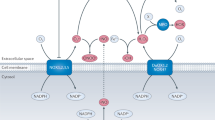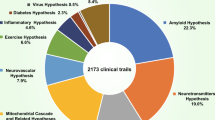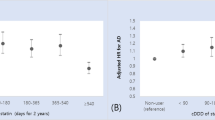Abstract
'Statins' are 3-hydroxy-3-methylglutaryl coenzyme A reductase inhibitors — oral cholesterol-lowering drugs that are used to treat hypercholesterolaemia. It is widely accepted that statins have anti-inflammatory effects that are independent of their ability to lower cholesterol. Animal studies and observational clinical studies have indicated that statins might also be effective in treating certain neurological diseases — in particular, multiple sclerosis, Alzheimer's disease and ischaemic stroke. At present, however, results from ongoing prospective, randomized clinical trials are not available.
This is a preview of subscription content, access via your institution
Access options
Subscribe to this journal
Receive 12 print issues and online access
$189.00 per year
only $15.75 per issue
Buy this article
- Purchase on Springer Link
- Instant access to full article PDF
Prices may be subject to local taxes which are calculated during checkout



Similar content being viewed by others
References
LaRosa, J. C., He, J. & Vupputuri, S. Effect of statins on risk of coronary disease: a meta-analysis of randomized controlled trials. JAMA 282, 2340–2346 (1999).
Ballantyne, C. M. et al. Risk for myopathy with statin therapy in high-risk patients. Arch. Intern. Med. 163, 553–564 (2003).
Graham, D. J. et al. Incidence of hospitalized rhabdomyolysis in patients treated with lipid-lowering drugs. JAMA 292, 2585–2590 (2004).
Ford, E. S., Mokdad, A. H., Giles, W. H. & Mensah, G. A. Serum total cholesterol concentrations and awareness, treatment, and control of hypercholesterolemia among US adults: findings from the National Health and Nutrition Examination Survey, 1999 to 2000. Circulation 107, 2185–2189 (2003).
Kobashigawa, J. A. et al. Effect of pravastatin on outcomes after cardiac transplantation. N. Engl. J. Med. 333, 621–627 (1995).
Willerson, J. T. & Ridker, P. M. Inflammation as a cardiovascular risk factor. Circulation 109, II2–II10 (2004).
Heart Protection Study Collaborative Group. MRC/BHF Heart Protection Study of cholesterol lowering with simvastatin in 20,536 high-risk individuals: a randomised placebo-controlled trial. Lancet 360, 7–22 (2002).
Topol, E. J. Intensive statin therapy — a sea change in cardiovascular prevention. N. Engl. J. Med. 350, 1562–1564 (2004).
Stanislaus, R., Pahan, K., Singh, A. K. & Singh, I. Amelioration of experimental allergic encephalomyelitis in Lewis rats by lovastatin. Neurosci. Lett. 269, 71–74 (1999).
Youssef, S. et al. The HMG-CoA reductase inhibitor, atorvastatin, promotes a Th2 bias and reverses paralysis in central nervous system autoimmune disease. Nature 420, 78–84 (2002).
Aktas, O. et al. Treatment of relapsing paralysis in experimental encephalomyelitis by targeting Th1 cells through atorvastatin. J. Exp. Med. 197, 725–733 (2003).
Weitz-Schmidt, G. et al. Statins selectively inhibit leukocyte function antigen-1 by binding to a novel regulatory integrin site. Nature Med. 7, 687–692 (2001).
Romano, M. et al. Inhibition of monocyte chemotactic protein-1 synthesis by statins. Lab. Invest. 80, 1095–1100 (2000).
Bellosta, S. et al. HMG-CoA reductase inhibitors reduce MMP-9 secretion by macrophages. Arterioscler. Thromb. Vasc. Biol. 18, 1671–1678 (1998).
Neuhaus, O. et al. Statins as immunomodulators: comparison with interferon-β 1b in MS. Neurology 59, 990–997 (2002).
Kieseier, B. C., Archelos, J. J. & Hartung, H. P. Different effects of simvastatin and interferon β on the proteolytic activity of matrix metalloproteinases. Arch. Neurol. 61, 929–932 (2004).
Sena, A., Pedrosa, R. & Graca, M. M. Therapeutic potential of lovastatin in multiple sclerosis. J. Neurol. 250, 754–755 (2003).
Vollmer, T. et al. Oral simvastatin treatment in relapsing-remitting multiple sclerosis. Lancet 363, 1607–1608 (2004).
Wechsler, A. et al. Generation of viable cholesterol-free mice. Science 302, 2087 (2003).
Refolo, L. M. et al. Hypercholesterolemia accelerates the Alzheimer's amyloid pathology in a transgenic mouse model. Neurobiol. Dis. 7, 321–331 (2000).
Sparks, D. L. et al. Induction of Alzheimer-like β-amyloid immunoreactivity in the brains of rabbits with dietary cholesterol. Exp. Neurol. 126, 88–94 (1994).
Fassbender, K. et al. Simvastatin strongly reduces levels of Alzheimer's disease β-amyloid peptides Aβ 42 and Aβ 40 in vitro and in vivo. Proc. Natl Acad. Sci. USA 98, 5856–5861 (2001).
Simons, M. et al. Treatment with simvastatin in normocholesterolemic patients with Alzheimer's disease: a 26-week randomized, placebo-controlled, double-blind trial. Ann. Neurol. 52, 346–350 (2002).
Fassbender, K. et al. Effects of statins on human cerebral cholesterol metabolism and secretion of Alzheimer amyloid peptide. Neurology 59, 1257–1258 (2002).
Akiyama, H. et al. Inflammation and Alzheimer's disease. Neurobiol. Aging 21, 383–421 (2000).
Kwak, B., Mulhaupt, F., Myit, S. & Mach, F. Statins as a newly recognized type of immunomodulator. Nature Med. 6, 1399–1402 (2000).
Yankner, B. A. et al. Neurotoxicity of a fragment of the amyloid precursor associated with Alzheimer's disease. Science 245, 417–420 (1989).
Pahan, K., Sheikh, F. G., Namboodiri, A. M. & Singh, I. Lovastatin and phenylacetate inhibit the induction of nitric oxide synthase and cytokines in rat primary astrocytes, microglia, and macrophages. J. Clin. Invest. 100, 2671–2679 (1997).
Naidu, A., Xu, Q., Catalano, R. & Cordell, B. Secretion of apolipoprotein E by brain glia requires protein prenylation and is suppressed by statins. Brain Res. 958, 100–111 (2002).
Gearing, M., Mori, H. & Mirra, S. S. Aβ-peptide length and apolipoprotein E genotype in Alzheimer's disease. Ann. Neurol. 39, 395–399 (1996).
Jick, H., Zornberg, G. L., Jick, S. S., Seshadri, S. & Drachman, D. A. Statins and the risk of dementia. Lancet 356, 1627–1631 (2000).
Wolozin, B., Kellman, W., Ruosseau, P., Celesia, G. G. & Siegel, G. Decreased prevalence of Alzheimer disease associated with 3-hydroxy-3-methyglutaryl coenzyme A reductase inhibitors. Arch. Neurol. 57, 1439–1443 (2000).
Rockwood, K. et al. Use of lipid-lowering agents, indication bias, and the risk of dementia in community-dwelling elderly people. Arch. Neurol. 59, 223–227 (2002).
Yaffe, K., Barrett-Connor, E., Lin, F. & Grady, D. Serum lipoprotein levels, statin use, and cognitive function in older women. Arch. Neurol. 59, 378–384 (2002).
Shepherd, J. et al. Pravastatin in elderly individuals at risk of vascular disease (PROSPER): a randomised controlled trial. Lancet 360, 1623–1630 (2002).
Li, G. et al. Statin therapy and risk of dementia in the elderly: a community-based prospective cohort study. Neurology 63, 1624–1628 (2004).
Casserly, I. & Topol, E. Convergence of atherosclerosis and Alzheimer's disease: inflammation, cholesterol, and misfolded proteins. Lancet 363, 1139–1146 (2004).
Amarenco, P. & Tonkin, A. M. Statins for stroke prevention: disappointment and hope. Circulation 109, III44–III49 (2004).
Collins, R., Armitage, J., Parish, S., Sleight, P. & Peto, R. Effects of cholesterol-lowering with simvastatin on stroke and other major vascular events in 20536 people with cerebrovascular disease or other high-risk conditions. Lancet 363, 757–767 (2004).
Sever, P. S. et al. Prevention of coronary and stroke events with atorvastatin in hypertensive patients who have average or lower-than-average cholesterol concentrations, in the Anglo-Scandinavian Cardiac Outcomes Trial—Lipid Lowering Arm (ASCOT-LLA): a multicentre randomised controlled trial. Lancet 361, 1149–1158 (2003).
Briel, M., Studer, M., Glass, T. R. & Bucher, H. C. Effects of statins on stroke prevention in patients with and without coronary heart disease: a meta-analysis of randomized controlled trials. Am. J. Med. 117, 596–606 (2004).
Kastelein, J. J., de Groot, E. & Sankatsing, R. Atherosclerosis measured by B-mode ultrasonography: effect of statin therapy on disease progression. Am. J. Med. 116 (Suppl. 6A), 31S–36S (2004).
Ross, R. Atherosclerosis — an inflammatory disease. N. Engl. J. Med. 340, 115–126 (1999).
Crisby, M. et al. Pravastatin treatment increases collagen content and decreases lipid content, inflammation, metalloproteinases, and cell death in human carotid plaques: implications for plaque stabilization. Circulation 103, 926–933 (2001).
Weber, C., Erl, W., Weber, K. S. & Weber, P. C. HMG-CoA reductase inhibitors decrease CD11b expression and CD11b-dependent adhesion of monocytes to endothelium and reduce increased adhesiveness of monocytes isolated from patients with hypercholesterolemia. J. Am. Coll. Cardiol. 30, 1212–1217 (1997).
Endres, M. et al. Stroke protection by 3-hydroxy-3-methylglutaryl (HMG)-CoA reductase inhibitors mediated by endothelial nitric oxide synthase. Proc. Natl Acad. Sci. USA 95, 8880–8885 (1998).
Ongini, E. et al. Nitric oxide (NO)-releasing statin derivatives, a class of drugs showing enhanced antiproliferative and antiinflammatory properties. Proc. Natl Acad. Sci. USA 101, 8497–8502 (2004).
Notarbartolo, A. et al. Inhibition of thromboxane biosynthesis and platelet function by simvastatin in type IIa hypercholesterolemia. Arterioscler. Thromb. Vasc. Biol. 15, 247–251 (1995).
Zacco, A. et al. 3-hydroxy-3-methylglutaryl coenzyme A reductase inhibitors protect cortical neurons from excitotoxicity. J. Neurosci. 23, 11104–11111 (2003).
Chen, J. et al. Statins induce angiogenesis, neurogenesis, and synaptogenesis after stroke. Ann. Neurol. 53, 743–751 (2003).
Chopp, M. et al. Postischemic administration of an anti-Mac-1 antibody reduces ischemic cell damage after transient middle cerebral artery occlusion in rats. Stroke 25, 869–875 (1994).
Sterzer, P. et al. Pravastatin improves cerebral vasomotor reactivity in patients with subcortical small-vessel disease. Stroke 32, 2817–2820 (2001).
Marti-Fabregas, J. et al. Favorable outcome of ischemic stroke in patients pretreated with statins. Stroke 35, 1117–1121 (2004).
Nissen, S. E. et al. Effect of intensive compared with moderate lipid-lowering therapy on progression of coronary atherosclerosis: a randomized controlled trial. JAMA 291, 1071–1080 (2004).
Amarenco, P. et al. Design and baseline characteristics of the Stroke Prevention by Aggressive Reduction in Cholesterol Levels (SPARCL) study. Cerebrovasc. Dis. 16, 389–395 (2003).
Hebert, L. E., Scherr, P. A., Bienias, J. L., Bennett, D. A. & Evans, D. A. Alzheimer disease in the US population: prevalence estimates using the 2000 census. Arch. Neurol. 60, 1119–1122 (2003).
Haake, M. et al. The German multicenter, randomized, partially blinded, prospective trial of acupuncture for chronic low-back pain: a preliminary report on the rationale and design of the trial. J. Altern. Complement. Med. 9, 763–770 (2003).
Smith, D. G. & McBurney, C. R. An economic analysis of the Atorvastatin Comparative Cholesterol Efficacy and Safety Study (ACCESS). Pharmacoeconomics 21 (Suppl. 1), 13–23 (2003).
Divis, D. A. BioWar: 'wild card' patent in Bioshield 2? The Washington Times (1 Sep 2004) <http://washingtontimes.com/upi-breaking/20040901-084333-2886r.htm>.
Vancura, A., Sessler, A., Leichus, B. & Kuret, J. A prenylation motif is required for plasma membrane localization and biochemical function of casein kinase I in budding yeast. J. Biol. Chem. 269, 19271–19278 (1994).
Wozniak, M. A., Kwong, L., Chodniewicz, D., Klemke, R. L. & Keely, P. J. R-Ras controls membrane protrusion and cell migration through the spatial regulation of Rac and Rho. Mol. Biol. Cell 16, 84–96 (2005).
Mundy, G. et al. Stimulation of bone formation in vitro and in rodents by statins. Science 286, 1946–1949 (1999).
Singh, R. et al. The IL-1 receptor and Rho directly associate to drive cell activation in inflammation. J. Clin. Invest. 103, 1561–1570 (1999).
Laufs, U. et al. Neuroprotection mediated by changes in the endothelial actin cytoskeleton. J. Clin. Invest. 106, 15–24 (2000).
Inoue, I. et al. Fibrate and statin synergistically increase the transcriptional activities of PPARα/RXRα and decrease the transactivation of NFκB. Biochem. Biophys. Res. Commun. 290, 131–139 (2002).
Baetta, R. et al. Proapoptotic effect of atorvastatin on stimulated rabbit smooth muscle cells. Pharmacol. Res. 36, 115–121 (1997).
Hernandez-Perera, O. et al. Effects of the 3-hydroxy-3-methylglutaryl-CoA reductase inhibitors, atorvastatin and simvastatin, on the expression of endothelin-1 and endothelial nitric oxide synthase in vascular endothelial cells. J. Clin. Invest. 101, 2711–2719 (1998).
Lawman, S., Mauri, C., Jury, E. C., Cook, H. T. & Ehrenstein, M. R. Atorvastatin inhibits autoreactive B cell activation and delays lupus development in New Zealand black/white F1 mice. J. Immunol. 173, 7641–7646 (2004).
Neuhaus, O., Stüve, O., Zamvil, S. S. & Hartung, H. P. Are statins a treatment option for multiple sclerosis? Lancet Neurol. 3, 369–371 (2004).
Author information
Authors and Affiliations
Corresponding author
Ethics declarations
Competing interests
The authors declare no competing financial interests.
Related links
Related links
DATABASES
Entrez Gene
FURTHER INFORMATION
Rights and permissions
About this article
Cite this article
Menge, T., Hartung, HP. & Stüve, O. Statins — a cure-all for the brain?. Nat Rev Neurosci 6, 325–331 (2005). https://doi.org/10.1038/nrn1652
Issue Date:
DOI: https://doi.org/10.1038/nrn1652
This article is cited by
-
Differential Membrane Dipolar Orientation Induced by Acute and Chronic Cholesterol Depletion
Scientific Reports (2017)
-
Production of valuable compounds by molds and yeasts
The Journal of Antibiotics (2017)
-
The role of atorvastatin on the restenosis process post-PTA in a diabetic rabbit model
BMC Cardiovascular Disorders (2016)
-
Role of Rho Kinase Inhibition in the Protective Effect of Fasudil and Simvastatin Against 3-Nitropropionic Acid-Induced Striatal Neurodegeneration and Mitochondrial Dysfunction in Rats
Molecular Neurobiology (2016)
-
Lipid metabolism in Alzheimer’s disease
Neuroscience Bulletin (2014)



